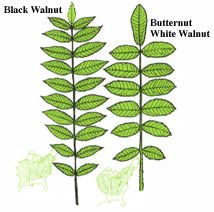| Leaf Identification / II
 Oaks Oaks
To the left, you can see leaves from three different
types of oak trees. The Pin Oak, Quercus
palustris, is found in the northern part of the U.S. and southern Canada,
in lowland areas with moderate shade. Its leaves are usually 3" to 4" with
5 lobes and a wedge-shaped base. The Jack Oak,
Quercus
ellipsoidalis, is found on higher ground and its lower branches are
usually dead. It has dark green leaves and the tree has an overall untidy
look. The Scarlet Oak, Quercus coccinea,
grows in sandy or gravelly areas. Looking at its leaves you will
find a thin, delicate blade with lobes that sometimes almost enclose oval
spaces. The mid-rib of the leaf is yellow.
Walnuts
 To
the right you can see two leaves from walnut trees. Leaflets arranged along
opposite sides of the stem like these are called pinnate
compound leaves (for more information,
see Leaf Terms). The Black
Walnut, Juglans nigra, is found
on high ground over a vast majority of the United States. It is somtimes
missing the end leaflet, and all the side leaflets are attached to the
stem at an angle. The Butternut White Walnut,
Juglans
cinerea, has an end leaflet, and its side leaflets are attached to
the stem perpendicularly. To
the right you can see two leaves from walnut trees. Leaflets arranged along
opposite sides of the stem like these are called pinnate
compound leaves (for more information,
see Leaf Terms). The Black
Walnut, Juglans nigra, is found
on high ground over a vast majority of the United States. It is somtimes
missing the end leaflet, and all the side leaflets are attached to the
stem at an angle. The Butternut White Walnut,
Juglans
cinerea, has an end leaflet, and its side leaflets are attached to
the stem perpendicularly.
continue to
Leaf ID III
Illustrations from Tree Finder by May Theilgaard Watts (c) 1963, 1991 Nature Study Guild, used by permission.
|
